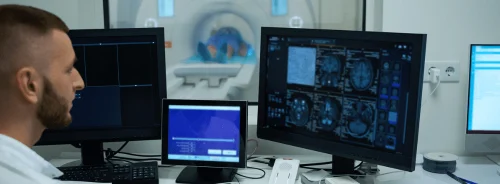In radiology practice, the reading room serves as the nerve centre where meticulous scrutiny of medical images occurs. Traditionally, the focus has been on precision and accuracy, with little thought given to the environment itself. However, the COVID-19 pandemic has prompted a reevaluation, revealing that remote work can enhance efficiency and performance. This shift begs the question: could redesigning the reading room optimise radiologist performance and patient outcomes?
Improved Ergonomics for Enhanced Comfort and Health
The foundation of a productive reading room begins with ergonomic design. Customised workstations and furniture play a pivotal role in mitigating physical strain and promoting well-being. Adjustable chairs and desks cater to diverse body types, ensuring optimal posture and reducing the risk of musculoskeletal injuries. Elevated monitors and ergonomic keyboards further enhance comfort, allowing radiologists to maintain focus without compromising physical health. Incorporating breaks and movement options like standing desks or active seating encourages circulation and combats the sedentary nature of the job.
Balancing Collaboration and Individual Focus
Effective teamwork and solitary concentration are equally vital in a dynamic reading room environment. Designated meeting rooms equipped with advanced technology facilitate seamless discussions and decision-making, fostering collaboration among radiologists. Brainstorming zones encourage creativity with tools like whiteboards and digital platforms for idea generation. Informal gathering spaces promote camaraderie and spontaneous exchanges, enhancing team cohesion and morale. Implementing these multifaceted spaces ensures that radiologists can collaborate effectively while also achieving deep, uninterrupted focus when needed.
Pertinent Principles in Accessibility and Organisation
Accessibility and organisation are cornerstones of an efficient reading room. Clear pathways and accessible facilities accommodate all team members, promoting a seamless workflow. Effective storage solutions minimise clutter, enabling quick access to essential resources and reducing stress. Personalised storage areas and organised workspaces enhance efficiency, allowing radiologists to concentrate on diagnostic tasks without distractions.
The modern reading room must evolve to meet the demands of contemporary radiology practice. By integrating ergonomic principles, fostering collaboration, ensuring accessibility, optimising organisation, and encouraging personalisation, we can create environments that enhance both radiologist performance and patient care. Future research should focus on longitudinal studies to measure the impact of these innovations on clinical outcomes and patient satisfaction. Through continuous refinement and adaptation, the reading room can uphold its role as a vital hub for efficient, comfortable, and high-quality healthcare delivery in the years to come.
Source: Diagnostic Imaging
Image Credit: iStock






